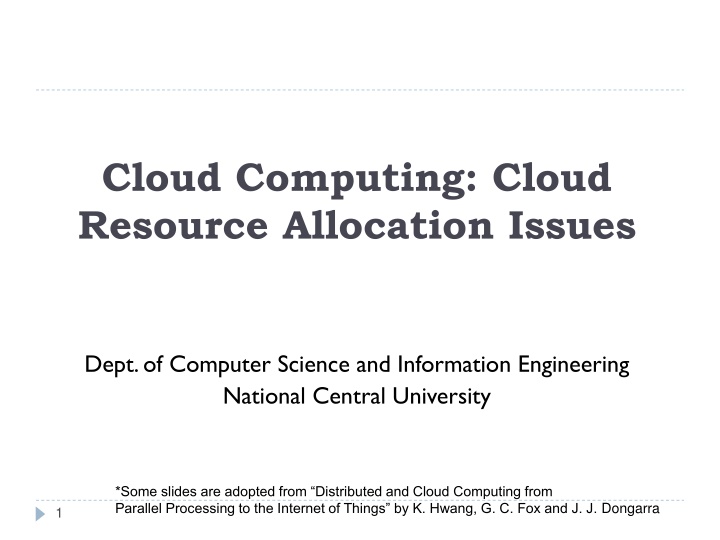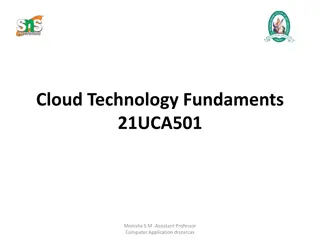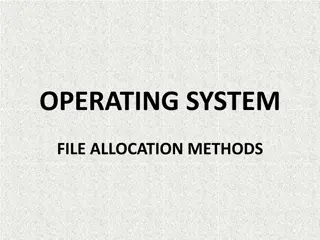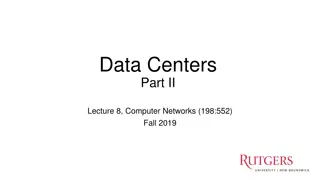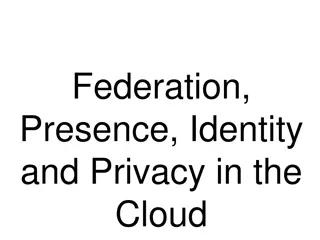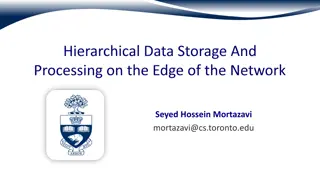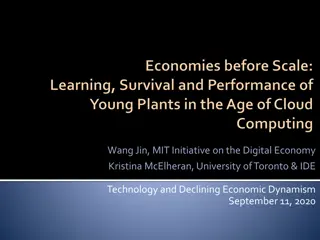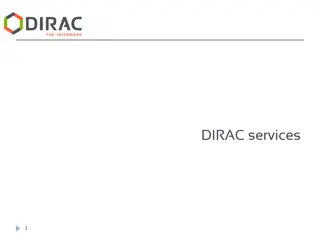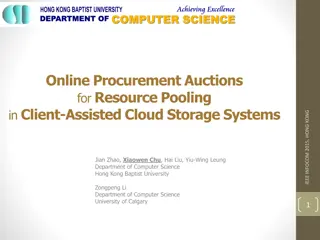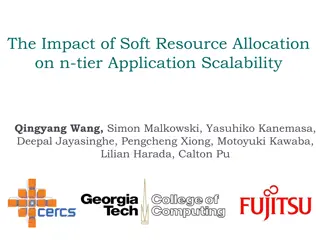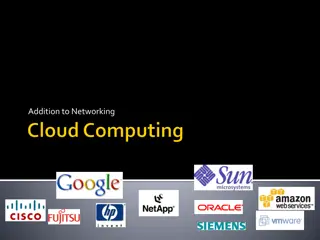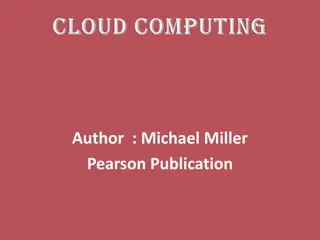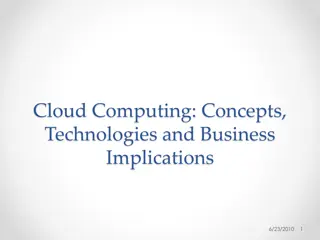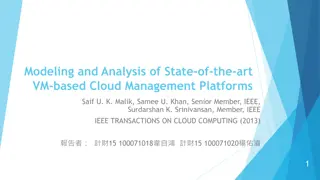Cloud Computing: Cloud Resource Allocation Issues
Cloud computing resource allocation and scheduling are critical functions affecting system performance, functionality, performance, and cost. This involves allocating resources like CPU cycles, memory, storage space, and network bandwidth to tasks and users efficiently and effectively. The challenges in cloud resource management include multi-objective optimization, complex policies, unpredictable events, and fluctuating workloads. Various policies and mechanisms guide resource allocation decisions.
Download Presentation

Please find below an Image/Link to download the presentation.
The content on the website is provided AS IS for your information and personal use only. It may not be sold, licensed, or shared on other websites without obtaining consent from the author.If you encounter any issues during the download, it is possible that the publisher has removed the file from their server.
You are allowed to download the files provided on this website for personal or commercial use, subject to the condition that they are used lawfully. All files are the property of their respective owners.
The content on the website is provided AS IS for your information and personal use only. It may not be sold, licensed, or shared on other websites without obtaining consent from the author.
E N D
Presentation Transcript
Cloud Computing: Cloud Resource Allocation Issues Dept. of Computer Science and Information Engineering National Central University *Some slides are adopted from Distributed and Cloud Computing from Parallel Processing to the Internet of Things by K. Hwang, G. C. Fox and J. J. Dongarra 1
Outline Cloud Resource Allocation and Scheduling Overview Overview of IaaS Scheduling Overview of PaaS/SaaS Scheduling 2
Overview of Cloud Resource Allocation and Scheduling 4
Resource Allocation and Scheduling Resource allocation: an approach/mechanism to allocate resources to tasks/users Scheduling: Scheduling is the approach/mechanism to find a schedule for all the resources that can serve all the tasks, given a set of resources and a set of tasks. A task may have dependency on other tasks 5
Computer Resource Allocation and Scheduling Critical function of any man-made system. It affects the three basic criteria for measuring system performance: Functionality. Performance. Cost. Scheduling in a computing system deciding how to allocate resources of a system, such as CPU cycles, memory, secondary storage space, I/O and network bandwidth, between users and tasks. Policies and mechanisms for resource allocation. Policy principles guiding decisions. Mechanisms the means to implement policies. 6
Resource Allocation and Scheduling on the Cloud It cannot violate cloud management policies This kind of problem is usually hard: Multi-objective optimization under complex policies and constraints Impossible to get accurate global state information. Affected by unpredictable events (e.g. system failures, attacks). Cloud service providers are faced with large fluctuating workloads/demands. The strategies for IaaS, PaaS, and SaaS are different. 7
Cloud Resource Management (CRM) Policies Admission control prevent the system from accepting workload in violation of high-level system policies. 1. Capacity allocation allocate resources for individual activations of a service. 2. Load balancing distribute the workload evenly among the servers. 3. Energy optimization minimization of energy consumption. 4. Quality of service (QoS) guarantees ability to satisfy timing or other conditions specified by a Service Level Agreement. 5. 8
Mechanisms for the Implementation of Resource Management Policies Control theory uses the feedback to guarantee system stability and predict transient behavior. Machine learning does not need a performance model of the system. Utility-based require a performance model and a mechanism to correlate user-level performance with cost. Market-oriented/economic do not require a model of the system, e.g., combinatorial auctions for bundles of resources. 9
Resource Allocation in Cloud Computing Typical cloud resource allocation problems PaaS-> Workflow (job) Scheduling IaaS-> Virtual Machine Placement (or Scheduling) Scheduler decides which job/VM should go on which machine/VM. An effective scheduler can Reduce operational cost Reduce queue waiting time Increase resource utilization 10
Control Model Control Model disturbance r s ( k ) u* (k) Predictive filter Optimal controller Queuing dynamics (k ) forecast external traffic state feedback q(k) An Example of Cloud Control Mechanism 11
Overview of IaaS Resource Allocation Static VM Placement 13
Introduction to Static VM placement Definition: Virtual machines V1~Vn, are asked to be executed on physical machines P1~Pm, such that the user defined cost function G is optimized. VM VM VM VM VM VM Physical Machine Physical Machine Physical Machine Physical Machine Physical Machine 14
Static VM Placement: Assumptions Assumptions may be made: Each physical machine Pahas a list of k resources <Pra,1~Pra,k> and each VM Vbmay request different amount of resources <Vrb,1~Vrb,k >. The VMs are asked to be placed on the physical machines. Resources: # of CPUs, memory size, disk size, bandwidth guaranteed VMs can co-locate at a physical machine. Typically a physical machine cannot serve unlimited VMs because each physical resource is limited Running VM: 2 CPUs 4 GB memory 8 GB memory Deployment is OK VM: 1 CPU Running VM: 1 CPU 4 GB memory Physical Machine: 4 CPUs 16 GB memory Deployment is not OK VM: 1 CPU 15 8 GB memory
VM Placement: Cost Function 1. Money spent: There are p types of chargeable resources. Each VM Vbis associated with an expected per-hour-resource-usage list <Vrb,1~Vrb,p >, and each different cloud Ci has a fix price list <Vri,1~Vri,p> The placement of VMs must minimize the money to be spent. Fine-grained energy consumption: Similar to the money function. However, the problem usually only considers the CPU-usage and a given energy consumption function of the CPU-usage. The placement of VMs must minimize the energy consumption of the system The number of used physical machines (coarse-grained energy consumption): The placement of VMs must minimize the number of used physical machines. 2. 3. 16
VM Placement: Cost Function (Cont.) Load balancing: The placement makes a similar workload of each physical host Multi-objective optimization: Try to optimize several goals at a time. 4. 5. 17
Possible Strategies for Different Problems Resource provisioning without any cost function consideration) Best-fit, Worst-fit, First-fit, Second-Fit, Resource provisioning with the goal of optimizing a cost function Random Round-robin Heuristic algorithms: Longest job (biggest VM/expensive VM) first, Shortest job (smallest VM/cheapest VM) first Min-min, min-max, max-min Algorithms derived from meta-heuristics Ex. ant colony, swarm optimization, simulated annealing, Simulated marketing systems Probability-based random algorithms 18
Another Strategy: Combinatorial Auctions for Cloud Resources Users provide bids for desirable bundles and the price they are willing to pay. Prices and allocation are set as a result of an auction. Ascending Clock Auction, (ASCA) the current price for each resource is represented by a clock seen by all participants at the auction. The algorithm involves user bidding in multiple rounds; to address this problem the user proxies automatically adjust their demands on behalf of the actual bidders. Not used in real environment.
u1 Proxy x1(t) x2(t) u2 Proxy x3(t) Auctioneer u3 Proxy u ( ) 0 x t u xU(t) uU Proxy p(t+1) The schematics of the ASCA algorithm; to allow for a single round auction users are represented by proxies which place the bids xu(t). The auctioneer determines if there is an excess demand and, in that case, it raises the price of resources for which the demand exceeds the supply and requests new bids.
Overview of IaaS Resource Allocation Dynamic VM Placement 21
Effects of Live VM Migration Benefits: Shifting workload from one physical machine to another physical machine Continuous execution of a running VM Drawbacks: Network bandwidth consumption during migration Some VM migration methods do not allow any failure during migration, since the failure may crash the VM 22
Dynamic VM Placement Dynamic VM placement: Use VM migration to reconfigure the cloud system periodically Migration may introduce overheads Possible Goal: Re-optimize the cost function (used in static VM placement) The assumption is that resource usage of a VM is a time function. So reconfiguration may have benefits Disaster prevention Example case: a physical machine has been detected an abnormal working temperature. We can migrate the VM to another physical machine in advance since the abnormal physical machine may crash at any time. When to do reconfiguration: Periodically Event-driven 23
Overview of IaaS Resource Allocation Auto-Scaling 24
Auto-scaling problem Problem: how can we handle workload with the consideration of Quality-of-Service preservation and operational cost? User requests (workload) Front-End VM Front-End VM Front-End VM Strategy: Increase the power of the services Web service Back-End VM Back-End VM Back-End VM 25
Auto-Scaling It is a popular technology for web services Auto-scaling refers to the ability to dynamically increase/decrease the computing power of a system VM scaling: Horizontal scaling Adding new VMs to the system Vertical scaling Increasing the computing power of the working VMs Ex. adding new vCPUs and new virtual memory space 26
Issues of Auto-Scaling Auto-scaling issues: When to activate auto-scaling Cannot be too sensitive and too slow How many resources (VMs) should be increased/decreased Typically horizontal scaling is used Very few systems use vertical scaling 27
Strategy of Auto-Scaling: Reactive Auto- Scaling 28
Possible Reactive Strategies Demand-driven Event-driven Popularity-driven 29
Example: OpenStack Reactive Auto- Scaling 30
Strategy of Auto-Scaling: Predictive Auto-Scaling 31
Possible Predictive Strategies They can predict the resources that will be used Prediction workload Linear regression calculation [1] Using Chaos Theory to predict [2] Auto-regressive model[3] Bayesian Network with machine learning techniques[4] [1] K. Qazi, Yang Li, and A. Sohn, Workload Prediction of Virtual Machines for Harnessing Data Center Resources, in 2014 IEEE 7th International Conference on Cloud Computing (CLOUD), 2014, pp. 522 529. [2] L. Yazdanov and C. Fetzer, Lightweight automatic resource scaling for multi-tier web applications, in 2014 IEEE 7th International Conference on Cloud Computing (CLOUD), 2014, pp. 466 473 [3] A. Bashar, Autonomic scaling of Cloud Computing resources using BN-based prediction models, in 2013 IEEE 2nd International Conference on Cloud Networking (CloudNet), 2013, pp. 200 204 [4] L. Zhang, Y. Zhang, P. Jamshidi, L. Xu, and C. Pahl, Workload Patterns for Quality-Driven Dynamic Cloud Service Configuration and Auto- Scaling, in Proceedings of the 2014 IEEE/ACM 7th International Conference on Utility and Cloud Computing, 2014, pp. 156 165. 32
Comparison of Reactive and Predictive Strategies Reactive auto-scaling: Tell the system when to do auto-scaling Predictive auto-scaling: In most studies, it tells the system how to do auto-scaling Studies for temporal prediction are very few 34
Overview of IaaS Resource Allocation Choice: Private cloud or public cloud 35
Public Cloud or Private Data Center? Assume usage-based pricing Assume the customer s revenue is directly proportional to the total number of user-hours. 36
Decision Model (Simplified Standard Capital-Budgeting Format) for Purchase Purchased Net Present Value NPV>0 PTis the annual profit resulting from the purchased asset in year T; Cp IKis the firm s cost of capital, defined as the interest rate of its outstanding debt used to finance the purchase;( ) N is the asset s productive life in years; S is the asset s salvage value ( ) after N years; E is the asset s purchase (capital) cost. Tis the asset s expected annual operating cost at year T; 37
Decision Model (Simplified Standard Capital-Budgeting Format) for Lease Leased CTLis the leased asset s expected annual operating cost at year T; LTis the lease payment at year T; IRis the interest rate for financing the lease payments. 38
Decision Model buy-or-lease decision If the incremental NPV ( NPV) 0 buy; if NPV < 0 lease, where NPV = NPVP- NPVL. We assume V is an operator returning the minimum number of - sized disk drives needed to store V Gbytes of data. S: the expected end-of-life disk salvage value, CT: the operating cost in year T ET: the capital cost in year T, 41
Other Topics Network Bandwidth Allocation Soft real-time scheduling Hard real-time scheduling High Reliability/Availability issues What should the system do if a failure happened? Resource allocation for virtual clusters or virtual datacenters Emulating communication inside a physical host can reduce network bandwidth consumption Impact of dynamic load-balancing on virtual clusters 45
Overview of PaaS/SaaS Resource Allocation 46
Overview of PaaS/SaaS Resource Allocation Concept of PaaS/SaaS Scheduling 47
Terminology Definition Job A computing work unit that should be carried out by a processing unit Task A independent small piece of a job. A Job consists of one to many tasks. Processing unit Can be a CPU, a vCPU, a VM, a physical machine, a process, a software service Job/Task Queue A place that temporarily hold jobs/tasks 48
A Typical Scheduling Model Scheduler Jobs Jobs Dispatcher Workload/Time Estimator Decision Maker/ Scheduling Jobs Assign jobs Jobs Selector User Queues Monitor Jobs User Monitoring data collection Jobs User Processing Units 49
Job/Task and Processing Units Job (or task) properties: Priority Dependency Estimated work length measured in million instructions Deadline Resource usage model during execution Processing unit properties: Processing power such as million instructions per second (MIPS) Sharable or non-sharable Preemptable or non-preemptable 50
